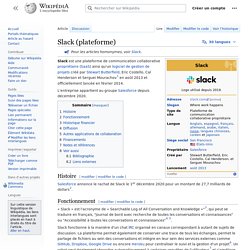

Diigo. Framemo. Lino. PLENTYPINS. Slack. Stoodle. Symbaloo. Trello. 20 useful ways to use Padlet in class now. Padlet is a web app that lets users post notes on a digital wall.

The uses for this site in the classroom are virtually endless! There’s a good chance you’ve done the “write on a sticky note and put it on the wall” activity — or have seen it happen before. Padlet lets those sticky notes have images, links and videos AND be available with practically any Internet-ready device. It used to be blocked by my school’s Internet filter. This school year, the powers that be have allowed it through on student devices, opening up lots of possibilities in class! Padlet is a great place for gathering ideas, sharing them and modifying them later. Here are 20 ways to use this versatile tool in class: 1. 2. 3. 4. 5 Alternatives to Padlet. For the last 24 hours the Twittersphere has been buzzing about the recent changes to Padlet.

While none of the following tools have as many features as Padlet, they all provide the core element of a digital wall to which you apply digital sticky notes. Here are five alternatives to Padlet. These are in the order in which I prefer them right now. LinoLino, sometime referred to as Lino.It, provides digital walls or corkboards to which you can add sticky notes that contain text, images, videos, or document attachments. Notes containing video links will play the video within your Lino wall. The best feature of Lino is the option to create private groups. WakeletWakelet is the newest entry into this market.
DotstormingDotstorming was built for people to share ideas in the form of digital sticky notes and then vote for their favorite ideas. ScrumblrScrumblr is a site that provides an online space to create and share sticky notes with a group. Slack : comment l'utiliser pour gagner en efficacité ? Il s'agit de l'application de collaboration d'entreprise de la génération Facebook et Twitter. Slack propose une nouvelle façon de travailler en équipe... en temps réel. Selon le dernier baromètre d'Okta, Slack se hisse en troisième position des applications SaaS à plus forte croissance en termes d'adoption. En mai 2018, l'outil de collaboration temps réel (ou team messaging en anglais) revendique 8 millions d'utilisateurs actifs quotidiens (dont plus de la moitié en dehors des Etats-Unis).
L'application est mise en œuvre dans 500 000 organisations, et 65% du Fortune 100. Quant au nombre d'abonnés à l'offre payante de la start-up, il atteint 3 millions pour un total de 70 000 équipes. En France, Slack comptait en septembre dernier 250 000 utilisateurs actifs hebdomadaires, ce qui ferait de l'Hexagone le troisième pays européen le plus présent sur la plateforme, après le Royaume-Uni et l'Allemagne.
La mise en place Un outil gratuit dans certaines limites Une offre Enterprise A lire aussi : Slack (plateforme) Un article de Wikipédia, l'encyclopédie libre.

Pour les articles homonymes, voir Slack. Slack est une plate-forme de communication collaborative propriétaire (SaaS) ainsi qu'un logiciel de gestion de projets créé par Stewart Butterfield (en), Eric Costello, Cal Henderson et Serguei Mourachov[1] en août 2013 et officiellement lancée en février 2014. En Juin 2019, la startup est valorisée à 20 milliards de dollars. Slack fonctionne à la manière d'un chat IRC organisé en canaux correspondant à autant de sujets de discussion.
La plateforme permet également de conserver une trace de tous les échanges (« Slack » est l'acronyme de « Searchable Log of All Conversation and Knowledge »[2]), permet le partage de fichiers au sein des conversations et intègre en leur sein des services externes comme GitHub, Dropbox, Google Drive ou encore Heroku pour centraliser le suivi et la gestion d'un projet[3]. La société a initialement levé près de 43 millions de dollars en avril 2014.
(en) Jeffrey M.